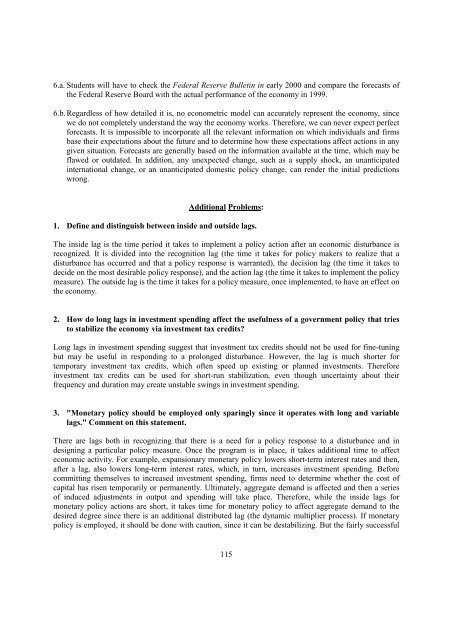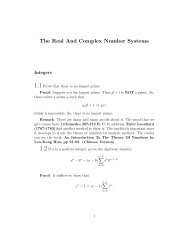Fiscal and monetary policy lags ⢠Automatic stabilizers ...
Fiscal and monetary policy lags ⢠Automatic stabilizers ...
Fiscal and monetary policy lags ⢠Automatic stabilizers ...
You also want an ePaper? Increase the reach of your titles
YUMPU automatically turns print PDFs into web optimized ePapers that Google loves.
6.a. Students will have to check the Federal Reserve Bulletin in early 2000 <strong>and</strong> compare the forecasts ofthe Federal Reserve Board with the actual performance of the economy in 1999.6.b. Regardless of how detailed it is, no econometric model can accurately represent the economy, sincewe do not completely underst<strong>and</strong> the way the economy works. Therefore, we can never expect perfectforecasts. It is impossible to incorporate all the relevant information on which individuals <strong>and</strong> firmsbase their expectations about the future <strong>and</strong> to determine how these expectations affect actions in anygiven situation. Forecasts are generally based on the information available at the time, which may beflawed or outdated. In addition, any unexpected change, such as a supply shock, an unanticipatedinternational change, or an unanticipated domestic <strong>policy</strong> change, can render the initial predictionswrong.Additional Problems:1. Define <strong>and</strong> distinguish between inside <strong>and</strong> outside <strong>lags</strong>.The inside lag is the time period it takes to implement a <strong>policy</strong> action after an economic disturbance isrecognized. It is divided into the recognition lag (the time it takes for <strong>policy</strong> makers to realize that adisturbance has occurred <strong>and</strong> that a <strong>policy</strong> response is warranted), the decision lag (the time it takes todecide on the most desirable <strong>policy</strong> response), <strong>and</strong> the action lag (the time it takes to implement the <strong>policy</strong>measure). The outside lag is the time it takes for a <strong>policy</strong> measure, once implemented, to have an effect onthe economy.2. How do long <strong>lags</strong> in investment spending affect the usefulness of a government <strong>policy</strong> that triesto stabilize the economy via investment tax credits?Long <strong>lags</strong> in investment spending suggest that investment tax credits should not be used for fine-tuningbut may be useful in responding to a prolonged disturbance. However, the lag is much shorter fortemporary investment tax credits, which often speed up existing or planned investments. Thereforeinvestment tax credits can be used for short-run stabilization, even though uncertainty about theirfrequency <strong>and</strong> duration may create unstable swings in investment spending.3. "Monetary <strong>policy</strong> should be employed only sparingly since it operates with long <strong>and</strong> variable<strong>lags</strong>." Comment on this statement.There are <strong>lags</strong> both in recognizing that there is a need for a <strong>policy</strong> response to a disturbance <strong>and</strong> indesigning a particular <strong>policy</strong> measure. Once the program is in place, it takes additional time to affecteconomic activity. For example, expansionary <strong>monetary</strong> <strong>policy</strong> lowers short-term interest rates <strong>and</strong> then,after a lag, also lowers long-term interest rates, which, in turn, increases investment spending. Beforecommitting themselves to increased investment spending, firms need to determine whether the cost ofcapital has risen temporarily or permanently. Ultimately, aggregate dem<strong>and</strong> is affected <strong>and</strong> then a seriesof induced adjustments in output <strong>and</strong> spending will take place. Therefore, while the inside <strong>lags</strong> for<strong>monetary</strong> <strong>policy</strong> actions are short, it takes time for <strong>monetary</strong> <strong>policy</strong> to affect aggregate dem<strong>and</strong> to thedesired degree since there is an additional distributed lag (the dynamic multiplier process). If <strong>monetary</strong><strong>policy</strong> is employed, it should be done with caution, since it can be destabilizing. But the fairly successful115
















